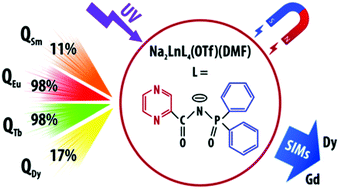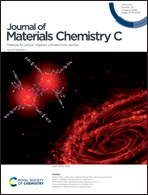Lanthanide complexes with N-phosphorylated carboxamide as UV converters with excellent emission quantum yield and single-ion magnet behavior†
Abstract
Lanthanide complexes with efficient antenna effect and multifunctional optical-magnetic activity are very appropriate for potential applications. Multidentate ligands efficiently sensitizing emission of different lanthanide ions are rare and complexes often suffer from bleaching. Presented here are photostable lanthanide complexes with single-magnet behavior as the first example in which, using the same sensitizer and the same excitation wavelength, extremely high overall emission quantum yields are achieved for various lanthanide ions (QLEu = QLTb = 98%, QLSm = 11%, QLDy = 17%). This is confirmed through computational and experimental analyses. We rationalize the process of energy transfer from the ligand to Eu3+, which was firstly understood in lanthanide compounds with N-phosphorylated carboxamides. The results revealed that in addition to the refractive index, the energy of the ligand triplet state and donor–acceptor distance, overall emission quantum yield is also a function of triplet state lifetime. It is demonstrated how proper design of the energetic and structural properties of the sensitizer and the introduction of excess Na ions into the structure of Ln complexes allow obtaining extremely efficient light converting molecular devices with single-ion magnet behavior.



 Please wait while we load your content...
Please wait while we load your content...